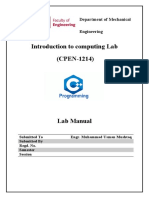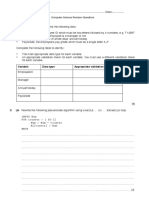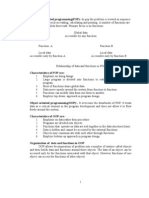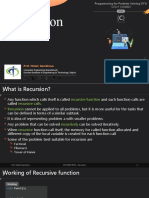Introduction To Problem Solving C++
Uploaded by
ridzuancomIntroduction To Problem Solving C++
Uploaded by
ridzuancomCHAPTER 1 INTRODUCTION TO PROBLEM SOLVING
Objectives
Introducing programming concept Introducing technique to develop a program
MOHD RIDZUAN B ABDUL RAHMAN BACHELOR IN COMPUTER FORENSIC MANAGEMENT & SCIENCE UNIVERSITY
TCS1013 INTRODUCTION TO PROGRAMMING
CHAPTER 1
1.1
Definition of Program, Programming and Programmer To understand program design in application software, user should know definitions of:
Program: A set of step-by-step instructions that directs a computer to perform a specific task and to produce the required results. Programming:
Programming is a process of designing or creating a program. Programmer:
Programmer is a person who writes the program.
1.1.1
Steps of Program Execution
INPUT (data)
PROCESS (processor)
OUTPUT (information)
Input Refer to the process of entering data, program and instructions into the
computer system using input devices.
Process Computer processed raw data into usable information to be used
by user. The process is done by the CPU (Central Processing Unit ).
Output Output is raw data that has been processed by the computer (result).
Output will be converted to understandable form before displayed or printed.
MOHD RIDZUAN B ABDUL RAHMAN
TCS1013 INTRODUCTION TO PROGRAMMING
CHAPTER 1
Example: Flow of ATM program Assume that our transaction is money withdrawal. The instructions are: a. Get card number from user (Input) b. Get pin number from user (Input) c. Process the input data (Process) d. Get the transaction chosen by user (Input) e. Get the account type from user (Input) f. Process the transaction (Process) g. Withdraw amount of money required by user (Output) h. Print Receipt for user (Output)
INPUT
PROCESS
OUTPUT
Input:
Example: Card number, pin number, type of transaction, type of account, amount of money to withdraw.
Process:
Example: Process to identify card number, valid pin number, type of transaction, type of account and deducts the withdrawal from user account.
Output:
Example: Receipt will show balance in user account and money withdrawal.
1.1.2
Executing A Program
To execute a program, CPU will examine each program instruction in memory and send out the required command signals to carry out the instruction. During execution, data can be entered into memory and manipulated in some specified way (delete and modify) as required. Program instructions are used to copy a program's data (data input) into memory.
MOHD RIDZUAN B ABDUL RAHMAN
TCS1013 INTRODUCTION TO PROGRAMMING
CHAPTER 1
After the input data are processed, instructions for displaying or printing are executed. Result displayed by a program is called program output.
Example: Money withdrawal from ATM machine.
Step 1
Input data: Card Number, PIN Number, and transaction.
Machine language program for processing card number and PIN number.
Step 2
Central Processing Unit.
Data entered during execution.
Step 3
Computed results. Program Output Output results: Receipt and money
First step: Data entered by user and stored in memory (input). Second step: CPU will instruct program to process the card number and ATM pin number with the data in memory at the same time. Program will execute the transaction choose by user and store the result in memory. Third step: The outputs are money and receipt (output).
1.2 Programming Process (Programming Life Cycle)
Cycle: Refers to the needs for changes of old program to new program (the cycle will start again). Programming Life Cycle: A framework or discipline, which using the techniques
needed in computer programming development.
MOHD RIDZUAN B ABDUL RAHMAN
TCS1013 INTRODUCTION TO PROGRAMMING
CHAPTER 1
Steps that involved programming life cycle:
PROBLEM ANALYSIS PROBLEM ANALYSIS PROGRAM DESIGN PROGRAM DESIGN PROGRAM CODING PROGRAM CODING TESTING AND DEBUGGING TESTING AND DEBUGGING MAINTENANCE MAINTENANCE
D O C U M E N T A T I O N
Documentation: Process of recording the steps carried out during the development. Documentation: Process of recording the steps carried out during the development. Each step must be completed before moving to next step. Each step must be completed before moving to next step.
STEP 1: PROBLEM ANALYSIS Purpose: To describe in details a solution to a problem by providing the needed information for the problem. How? o o o theories if any. Problem 1: Write a program that get 3 numbers as input from user. Find the average and display the numbers and the average. First, understand & study the problem. Identify: The input to the problem. The required output. The relevant process. For example, scientific formula or appropriate
MOHD RIDZUAN B ABDUL RAHMAN
TCS1013 INTRODUCTION TO PROGRAMMING
CHAPTER 1
Problem Analysis: Input: 3 numbers. Process: Output: 1. Add the numbers 2. Divide the total with 3 The 3 numbers and average
INPUT
PROCESS
OUTPUT
STEP 2: PROGRAM DESIGN
Definition: It defines the framework or the flow or the problem solution Method to design a program: 1.Algorithm
Algorithm is a sequence of instructions to solve a problem written in human A programmer writes the solution in the form of an algorithm before coding it Example of algorithm to calculate the average of 3 numbers: 1. 2. 3. 4. 5. Set Total=0, average=0; Input 3 numbers Total up the 3 numbers Total= total of 3 numbers Calculate average average=Total/3 Display 3 numbers and the average
language and problem can be solved if follow the correct procedure
into computer language.
2. Flowchart
A graphical representation of data, information and process or an orderly stepExample:
by-step solution to a problem.
MOHD RIDZUAN B ABDUL RAHMAN
TCS1013 INTRODUCTION TO PROGRAMMING
CHAPTER 1
S rt ta
In u a pt
, b, c
T ta o l
= a + b + c
ae g v ra e
= T ta o l
/3
D p ya is la , b, c D p ya e g is la v ra e
Ed n
3. Pseudocode Steps in problem solving written in certain of programming code and certain in human language.
For example, some part use C++ language code and some part use English-
like phrases. Example: START INPUT a, b, c Total = a + b + c average = Total / 3 OUTPUT a, b, c OUTPUT average END
STEPS 3: PROGRAM CODING
Definition: Write a solution into a specific programming language such as C, C++,
COBOL and etc. Solution: Instructions before it is coded into programming language. Purpose: To produce a program to develop a system.
MOHD RIDZUAN B ABDUL RAHMAN
TCS1013 INTRODUCTION TO PROGRAMMING
CHAPTER 1
# include <iostream.h> Example of syntax in C++ language to display instruction for user to enter 3 numbers on computer screen. main( ) { int a, b, c, HasilTambah; double purata; cout<<" Enter 3 numbers:"; cin>>a >> b >> c; HasilTambah = a + b + c; purata = HasilTambah / 3; cout<< a = <<a <<\n; cout<<b = <<b<<endl; cout<<\nc = <<c; cout<<"Average is = <<purata; return 0; }
Example of programming in C++ language:
#include<iostream.h> #include<conio.h> main( ) { int a,b,c; // input variables int sum; // variable - holds the result of (a + b + c) float avg; // output variable clrscr( ); // Ask user to enter 3 numbers cout<<"\n Input three numbers : "; cin>>a >> b >> c; sum = a + b + c; // calculate the addition of a, b, c avg = sum / 3; // calculate the average of a, b, c // display the average of the 3 numbers cout<<"\n Average of the numbers : "<<avg; return 0; }
Output Screen: Input: Three numbers entered by user. Input three numbers: 4 4 4 Average of the numbers: 4.00_
Output: The average of 3 numbers
MOHD RIDZUAN B ABDUL RAHMAN
TCS1013 INTRODUCTION TO PROGRAMMING
CHAPTER 1
STEP 4: TESTING AND DEBUGGING Definition of Testing:
Using a set of data to discover errors and to ensure accuracy of the program. Diagram indicates the process of testing. Output (functioning well or error discovered
Testing Process:
Input sample of data set Example 1:
Executing Program
Assume that a program to find the average of 3 numbers has been coded. Then, execute the program with a few sample data (value) in order to verify whether the program is functioning well and produce the accurate output (result). Testing 1: Input :4,5,8 Testing 2: Input :7,8,6 From the output, is the program produce the correct output?
Definition of Debugging:
An error is called as bug. Bug must be identified and corrected; the process is called debugging.
1.
Two types of error: Syntax Error (grammatical error) Occurs when the rules of programming language are not applied. It is usually found and corrected during coding a program. Can be traced by the compiler during compilation. Also known as compile-time error Must be corrected before executing and testing the program. Logic error Cannot be traced by compiler. Always found and corrected during problem solving. Also known as run time error. Example: The correct output is 4 but when it runs the output is 2.
2.
MOHD RIDZUAN B ABDUL RAHMAN
TCS1013 INTRODUCTION TO PROGRAMMING
CHAPTER 1
Syntax error will occur if any mistake in the program. Example: No semicolon.
Line 9 where the syntax error occurred.
Syntax error message
SYNTAX ERROR
#include<iostream.h> #include <conio.h> main() { int a, b, c; int sum; float avg; clrscr(); cout<<Input three numbers: ; cin>>a >> b >> c; sum = a + b + c; avg = sum/6; cout<<Average of the three numbers: <<avg; }
Logic error is an error that occurred Logic error is an error that occurred because of incorrect of logical statement because of incorrect of logical statement in program. in program. Example: Example: Sum is total of the 3 numbers. Sum is total of the 3 numbers. Supposed the average is sum / 3 Supposed the average is sum / 3 because there are 3 numbers. because there are 3 numbers.
Logic Error Logic Error Input three numbers: 444 Average of the numbers: 2
The wrong output The wrong output
LOGIC ERROR
MOHD RIDZUAN B ABDUL RAHMAN 10
TCS1013 INTRODUCTION TO PROGRAMMING
CHAPTER 1
STEP 5: MAINTENANCE Definition: Activity to verify that the operational system is still performing as planned or modified The process of changing a system after it has been applied is to maintain its ability. to enhance the system to meet the current requirement. The changes may involve simple changes such as correct errors, coding and enhancement. How to do maintenance? o By performing activities such as: Testing test the ability of the system. Measurement access data time. Example, time to save, print and others. Replacement replace the old system to new system. Adjustments adding needs to new system. Repairs Example, old system cannot update new data, Updating modify database.
o
o o o o
Example: Maintenance of Telecommunication System TELEKOM. Telecommunication digits. System TELEKOM provides
communication service from one house to another house. The telephone number is 7 o digits. o Programmer will change the old system to new system and test the system whether it functioning well or not. Assume that management wants to change 7 digits to 8
Then, new system will be tested its capability overall. For example, test the capability to identify callers and users location and time is taken to connect them (measurement).
o
function (replacement).
Any old function that no longer used will be replaced with new
STEP 6: DOCUMENTATION Definition: Documentation is a written report or graphic record of the steps carried out during the development of program.
MOHD RIDZUAN B ABDUL RAHMAN
11
TCS1013 INTRODUCTION TO PROGRAMMING
CHAPTER 1
Purpose:
It is useful in the future if the program needs modification/maintenance. It is a reference for the development team.
Content of Documentation: o o o o o o o Description of the program. Specification requirement of program Program design such as pseudocode and flowchart List of program and comments (to explain about the program). Test results. End user manual. Program capabilities and limitation.
Example: Problem solving using the steps in Programming Life Cycle Problem: To calculate total payment for fee in Murni Tuition Centre. Provided packages: Package 1 (RM 55): Package 2 (RM 50): Package 3 (RM 50): Package 4 (RM 55): Package 5 (RM 50): Package 6 (RM 55): STEP1: Problem Analysis Input: Subjects taken according to package Process: Calculate fees based on the package Output:Monthly fees to pay STEP 2: Algorithm 1. Package_1: RM 55 Package_2: RM 50 Package_3: RM 50 Package_4: RM 55 Package_5: RM 50 Package_6: RM 55 2. 3. 4. Fee = Fee + Package_1 Else Set Fee = 0 Enter name and package If Package = 1 Set payment: Bahasa Melayu, Bahasa Inggeris, Sejarah Matematik, Sains, Geografi Bahasa Melayu, Matematik, Sejarah Bahasa Inggeris, Sains, Geografi Bahasa Melayu, Sains, Geografi Bahasa Inggeris, Matematik, Sejarah
MOHD RIDZUAN B ABDUL RAHMAN
12
TCS1013 INTRODUCTION TO PROGRAMMING
CHAPTER 1
If Package = 2 Fee = Fee + Package_2 Else If Package = 3 Fee = Fee + Package_3 Else If Package = 4 Fee = Fee + Package_4 Else If Package = 5 Fee = Fee + Package_5 Else If Package = 6 Fee = Fee + Package_6 Else Invalid data 5. Display name and fee Flowchart
MOHD RIDZUAN B ABDUL RAHMAN
13
TCS1013 INTRODUCTION TO PROGRAMMING
CHAPTER 1
START
Package _1: RM 55 Package _2: RM 50 P ackage _3: RM 50 Package _4: RM 55 Package _5: RM 50 Package _6: RM 55
Fee = 0
Input name , Package
If Package =1 If Package =2
Fee = Fee + Package _1
Fee = Fee + Package _2
If Package 3
Fee = Fee + Package _3
If Package 4
Fee = Fee + Package _4
If Package 5
Fee = Fee + Package _5 If Package 6 Fee = Fee + Package _6 =
Invalid data Continue ?
Display name and fee
END
Pseudocode START Package_1= RM 55 Package_2= RM 50 Package_3= RM 50 Package_4= RM 55 Package_5= RM 50 Package_6= RM 55 Fee = 0 Input name, Package If Package = 1 Fee = Fee + Package_1 Else If Package = 2 Fee = Fee + Package_2 Else If Package = 3 Fee = Fee + Package_3
MOHD RIDZUAN B ABDUL RAHMAN
14
TCS1013 INTRODUCTION TO PROGRAMMING
CHAPTER 1
Else If Package = 4 Fee = Fee + Package_4 Else If Package = 5 Fee = Fee + Package_5 Else If Package = 6 Fee = Fee + Package_6 Else Invalid Data OUPUT name, Fee END STEP 3: Program Coding (C Language) #include <iostream.h> main () { float Package_1= 55, Package_2= 50, Package_3= 50, Package_4= 55; float Package_5= 50 , Package_6= 55, Fee = 0; cout<<Enter student name:<<\n; cin>> nama; do{ cout<<Enter Package: <<\n; cin >>Package; if (Package == 1) Fee = Fee + Package_1; else if (Package == 2) Fee = Fee + Package_2; else if (Package == 3) Fee = Fee + Package_3; else if (Package == 4) Fee = Fee + Package_4; else if (Package == 5) Fee = Fee + Package_5; else if (Package == 6) Fee = Fee + Package_6; else cout<<Invalid data; cout<<Do you want to continue?; cin>>terus; } while (terus == Y); cout<<Name: <<nama; cout<<Monthly fee to pay:<<Fee; } STEP 4: Testing and Debugging
MOHD RIDZUAN B ABDUL RAHMAN
15
TCS1013 INTRODUCTION TO PROGRAMMING
CHAPTER 1
No error has detected. Program runs efficiently after testing. Output as required.
STEP 5: Maintenance o Maintenance to enable the program to process number of students in one time. Programmer will modify current system to new system and test the system whether its functioning or not.
o
data (measurement).
Then, new system will be tested overall. For example, test the capability to process students data in one time and the duration to process the
o
function (replacement).
Any old function that no longer used will be replaced with new
MOHD RIDZUAN B ABDUL RAHMAN
16
You might also like
- Computer Science - Introduction to Problem SolvingNo ratings yetComputer Science - Introduction to Problem Solving38 pages
- Work Sheet No. 1 STACK Implementation Using Array Name: - Reg - No.: - DateNo ratings yetWork Sheet No. 1 STACK Implementation Using Array Name: - Reg - No.: - Date12 pages
- Introduction To Computing Lab (CPEN-1214) : Department of Mechanical EngineeringNo ratings yetIntroduction To Computing Lab (CPEN-1214) : Department of Mechanical Engineering32 pages
- Topic: 4.1.3 Abstract Data Types (ADT) : Chapter: 4.1 Computational Thinking and Problem-SolvingNo ratings yetTopic: 4.1.3 Abstract Data Types (ADT) : Chapter: 4.1 Computational Thinking and Problem-Solving6 pages
- Lecture 0 Algorithm Flowchart PseudocodeNo ratings yetLecture 0 Algorithm Flowchart Pseudocode26 pages
- Homework #07 - Answers: Jatinder Uses Internet Banking. This Pseudocode Checks Her PINNo ratings yetHomework #07 - Answers: Jatinder Uses Internet Banking. This Pseudocode Checks Her PIN100 pages
- Fundamentals of Programming: Lab Practical Week 1 ObjectiveNo ratings yetFundamentals of Programming: Lab Practical Week 1 Objective6 pages
- COSC - 3104 - Compiler Construction, 16-Weeks Plan Course Outline100% (1)COSC - 3104 - Compiler Construction, 16-Weeks Plan Course Outline6 pages
- Theory of Automata (CS402) Assignment No.1 Solution: Question No.1 Recursive DefinitionNo ratings yetTheory of Automata (CS402) Assignment No.1 Solution: Question No.1 Recursive Definition5 pages
- Final Course Outline Programming Fundamentals0% (1)Final Course Outline Programming Fundamentals11 pages
- Capgemini Pseudo Code Questions With AnswerNo ratings yetCapgemini Pseudo Code Questions With Answer21 pages
- Computer Science Paper 2 Final Revision Questions - 2017No ratings yetComputer Science Paper 2 Final Revision Questions - 20179 pages
- Brute Force: Design and Analysis of Algorithms - Chapter 3 1No ratings yetBrute Force: Design and Analysis of Algorithms - Chapter 3 118 pages
- Ge1105 Problem Solving and Python Programming Unit - 1100% (1)Ge1105 Problem Solving and Python Programming Unit - 1133 pages
- Aissce Practical Exam CS Question Paper - 2023-24No ratings yetAissce Practical Exam CS Question Paper - 2023-245 pages
- Introduction To Algorithms: Chapter 3: Growth of FunctionsNo ratings yetIntroduction To Algorithms: Chapter 3: Growth of Functions29 pages
- 16-Describe Actions Inside The Processing ChipNo ratings yet16-Describe Actions Inside The Processing Chip1 page
- Lecture 2: Problem Solving Using State Space RepresentationNo ratings yetLecture 2: Problem Solving Using State Space Representation37 pages
- (Lab-5 Manual) CS-204-DSA - Time Complexity AnalysisNo ratings yet(Lab-5 Manual) CS-204-DSA - Time Complexity Analysis5 pages
- Computer Science: Practical File Python Programs & Mysql0% (1)Computer Science: Practical File Python Programs & Mysql31 pages
- Design and Analysis of Algorithms (DAA) NotesNo ratings yetDesign and Analysis of Algorithms (DAA) Notes169 pages
- Computational Problem Solving: Chapter 1, Sections 1.5-1.7100% (1)Computational Problem Solving: Chapter 1, Sections 1.5-1.739 pages
- TCB2073 - Lecture 1 Introduction To Problem SolvingNo ratings yetTCB2073 - Lecture 1 Introduction To Problem Solving27 pages
- Intelligent Systems: University of Colombo School of ComputingNo ratings yetIntelligent Systems: University of Colombo School of Computing26 pages
- Languages and Compilers (Sprog Og Oversættere) : Bent Thomsen Department of Computer Science Aalborg UniversityNo ratings yetLanguages and Compilers (Sprog Og Oversættere) : Bent Thomsen Department of Computer Science Aalborg University41 pages
- Extra Ignition Materials - Inductive AutomationNo ratings yetExtra Ignition Materials - Inductive Automation5 pages
- 376-2 Susan Athey Opening Opinion SummariesNo ratings yet376-2 Susan Athey Opening Opinion Summaries5 pages
- Research Papers On Concurrency Control in Distributed DatabaseNo ratings yetResearch Papers On Concurrency Control in Distributed Database6 pages
- TechnoTween Module 1 - Animator - S Tool TechnoKids PHNo ratings yetTechnoTween Module 1 - Animator - S Tool TechnoKids PH13 pages
- Software Technical Specification TemplateNo ratings yetSoftware Technical Specification Template9 pages
- MIL 8. Opportunities Challenges and Power of Media and InformationNo ratings yetMIL 8. Opportunities Challenges and Power of Media and Information15 pages
- Transaction Propagation and Isolation in Spring @transactionalNo ratings yetTransaction Propagation and Isolation in Spring @transactional11 pages
- Digital Electronic & Fundamentals of Microprocessor: B.E. Third Semester (Information Technology) (C.B.S.)No ratings yetDigital Electronic & Fundamentals of Microprocessor: B.E. Third Semester (Information Technology) (C.B.S.)2 pages
- Computer Science - Introduction to Problem SolvingComputer Science - Introduction to Problem Solving
- Work Sheet No. 1 STACK Implementation Using Array Name: - Reg - No.: - DateWork Sheet No. 1 STACK Implementation Using Array Name: - Reg - No.: - Date
- Introduction To Computing Lab (CPEN-1214) : Department of Mechanical EngineeringIntroduction To Computing Lab (CPEN-1214) : Department of Mechanical Engineering
- Topic: 4.1.3 Abstract Data Types (ADT) : Chapter: 4.1 Computational Thinking and Problem-SolvingTopic: 4.1.3 Abstract Data Types (ADT) : Chapter: 4.1 Computational Thinking and Problem-Solving
- Homework #07 - Answers: Jatinder Uses Internet Banking. This Pseudocode Checks Her PINHomework #07 - Answers: Jatinder Uses Internet Banking. This Pseudocode Checks Her PIN
- Fundamentals of Programming: Lab Practical Week 1 ObjectiveFundamentals of Programming: Lab Practical Week 1 Objective
- COSC - 3104 - Compiler Construction, 16-Weeks Plan Course OutlineCOSC - 3104 - Compiler Construction, 16-Weeks Plan Course Outline
- Theory of Automata (CS402) Assignment No.1 Solution: Question No.1 Recursive DefinitionTheory of Automata (CS402) Assignment No.1 Solution: Question No.1 Recursive Definition
- Computer Science Paper 2 Final Revision Questions - 2017Computer Science Paper 2 Final Revision Questions - 2017
- Brute Force: Design and Analysis of Algorithms - Chapter 3 1Brute Force: Design and Analysis of Algorithms - Chapter 3 1
- Ge1105 Problem Solving and Python Programming Unit - 1Ge1105 Problem Solving and Python Programming Unit - 1
- Introduction To Algorithms: Chapter 3: Growth of FunctionsIntroduction To Algorithms: Chapter 3: Growth of Functions
- Lecture 2: Problem Solving Using State Space RepresentationLecture 2: Problem Solving Using State Space Representation
- (Lab-5 Manual) CS-204-DSA - Time Complexity Analysis(Lab-5 Manual) CS-204-DSA - Time Complexity Analysis
- Computer Science: Practical File Python Programs & MysqlComputer Science: Practical File Python Programs & Mysql
- Computational Problem Solving: Chapter 1, Sections 1.5-1.7Computational Problem Solving: Chapter 1, Sections 1.5-1.7
- TCB2073 - Lecture 1 Introduction To Problem SolvingTCB2073 - Lecture 1 Introduction To Problem Solving
- Intelligent Systems: University of Colombo School of ComputingIntelligent Systems: University of Colombo School of Computing
- Languages and Compilers (Sprog Og Oversættere) : Bent Thomsen Department of Computer Science Aalborg UniversityLanguages and Compilers (Sprog Og Oversættere) : Bent Thomsen Department of Computer Science Aalborg University
- Research Papers On Concurrency Control in Distributed DatabaseResearch Papers On Concurrency Control in Distributed Database
- TechnoTween Module 1 - Animator - S Tool TechnoKids PHTechnoTween Module 1 - Animator - S Tool TechnoKids PH
- MIL 8. Opportunities Challenges and Power of Media and InformationMIL 8. Opportunities Challenges and Power of Media and Information
- Transaction Propagation and Isolation in Spring @transactionalTransaction Propagation and Isolation in Spring @transactional
- Digital Electronic & Fundamentals of Microprocessor: B.E. Third Semester (Information Technology) (C.B.S.)Digital Electronic & Fundamentals of Microprocessor: B.E. Third Semester (Information Technology) (C.B.S.)





























































































